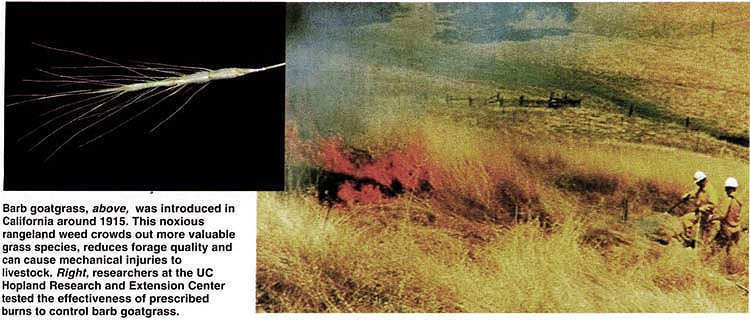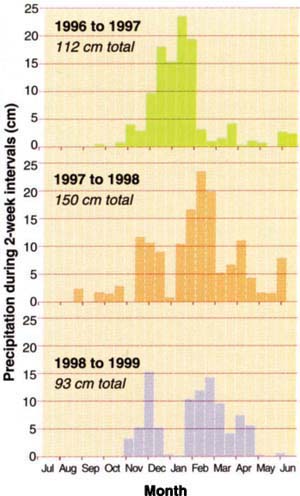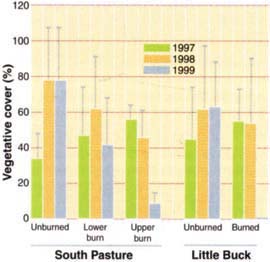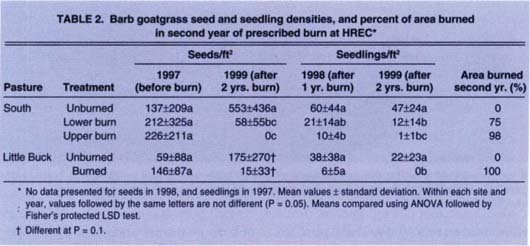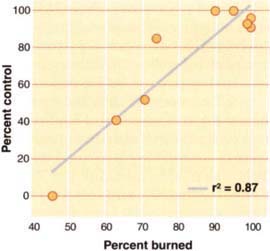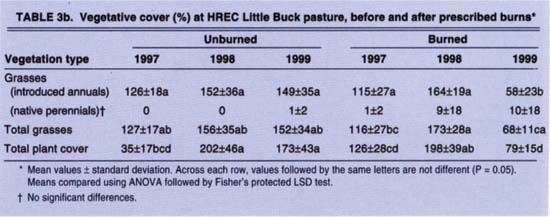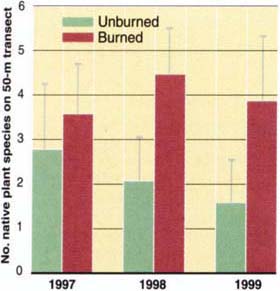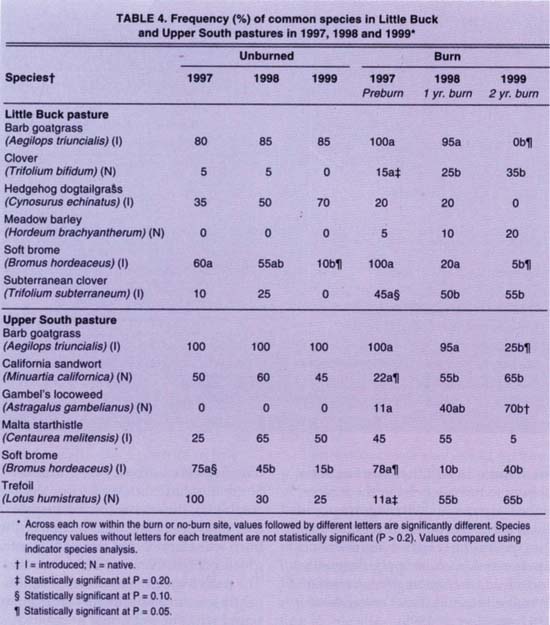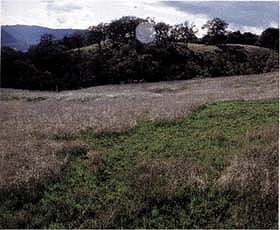All Issues
Carefully timed burning can control barb goatgrass
Publication Information
California Agriculture 55(6):47-53. https://doi.org/10.3733/ca.v055n06p47
Published November 01, 2001
PDF | Citation | Permissions
Abstract
Barb goatgrass is a noxious annual grass that is rapidly invading California's grassland ecosystems. No effective control strategies for managing barb goatgrass have been available that do not simultaneously injure other more desirable grass and broadleaf species. In our study at the UC Hopland Research and Extension Center, we conducted prescribed burning in late spring or early summer before barb goatgrass seeds had reached maturation. One year of prescribed burning was not sufficient to control re-establishment the following year. However, 2 years of complete burning gave effective control of barb goatgrass while increasing native perennial grass cover and native species richness, particularly legumes. The success of the goatgrass control was directly proportional to the completeness of the second-year burn.
Full text
Barb goatgrass, above, was introduced in California around 1915. This noxious rangeland weed crowds out more valuable grass species, reduces forage quality and can cause mechanical injuries to livestock. Right, researchers at the UC Hopland Research and Extension Center tested the effectiveness of prescribed burns to control barb goatgrass.
Three species of goatgrass occur in California: jointed, ovate and barb goatgrass. All three species are winter annual grasses introduced early in the 20th century from Mediterranean Europe and western Asia. They are closely related to winter wheat (Triti-cum aestivum) and have been shown to hybridize with the cereal crop, in the Western states, jointed goatgrass is the most widespread species within the genus and is a serious problem for cereal crops, particularly winter wheat. Unlike jointed goatgrass, ovate (Aegilops ovata) and barb goatgrass are invasive primarily in disturbed and undisturbed grasslands and pastures.
Barb goatgrass (A. triuncialis) probably first introduced to California around 1915. From early records, it was reported to crowd out other valuable range species, reduce forage quality and quantity, and injure livestock when its barb awns (slender, bristle-like appendages with sharp “hooks”) became lodged in their noses, mouths or eyes (Kennedy 1928). Once a grassland became infested with barb goatgrass, estimates indicated that livestock range capacity (the number of cattle the acreage can support) was reduced by 50% to 75% (Jacobsen 1929). By the late 1920s it had spread to thousands of acres, but the infestations were local and restricted to two counties, Calaveras and El Dorado (Talbot and Smith 1930). Despite its limited distribution, state and county officials made an effort to eradicate barb goatgrass. At that time, however, few options were available. Burning was used as a control measure, but prescribed burns were generally conducted either too early, when controlled fires were not sufficiently hot, or too late, when seedheads were more resistant to destruction. Consequently, burning as a control strategy was considered unreliable unless it was combined with a previous mowing or oil treatment (Talbot and Smith 1930).
The control efforts in the early part of the 20th century probably slowed the spread of barb goatgrass, which can rapidly move through livestock transfers and contaminate vehicles or equipment. Nevertheless, by 1973 it had expanded its range in the Central Valley and coastal foothills and was reported to occur in about 13 counties. By 1995, it had spread to 21 California counties (Peters et al. 1996). Today, barb goatgrass is a state-listed noxious weed in California and has also been listed as a noxious weed in Oregon, although it has not been reported there yet.
From top to bottom: Barb goatgrass seedheads remain on the soil surface after a prescribed burn; a native perennial grass (Hordeum brachyantherum) recovers rapidly; native forbs are prolific in the spring following the burn; 2 years later, barb goatgrass has been controlled on a Hopland pasture (unburned check plot can be seen in the background).
Despite 70 years of attempted management of barb goatgrass, no new effective control options were developed. Although many new herbicides are currently registered for use in grasslands and pastures, none provide selective control of barb goatgrass without damaging other desirable grasses (Peters et al. 1996). Burning remains potentially the most successful strategy, but little effort has been made to enhance its effectiveness with more-specific timing recommendations. Although not directed at barb goatgrass control, other studies using carefully timed burns have proved successful for native grassland restoration by reducing the cover of alien species while increasing the cover and diversity of native species (Menke 1992; Meyer and Schiffman 1999).
Many invasive and undesirable annual grasses, including barb goatgrass, medusahead (Taeniatherum caput-medusae) and ripgut brome (Bromus diandrus), have long barb awns that help facilitate their dispersal on clothing or on the hair, fur or wool of animals. To maximize the probability of dispersal, seeds (caryopses) remain attached on the inflorescence (flowering structures) much longer into the season than most desirable annual grass and broadleaf species. In medusahead, for example, Murphy and Lusk (1961) showed that seeds developed about 20 days after soft brome (Bromus hordeaceus), a more desirable annual grass.
Exposed seeds remaining attached to the culm (stem) are more vulnerable to grassland fires than are seeds on the soil surface. Studies on jointed goatgrass (A. cylindrica) demonstrated that seeds directly exposed to flame for more than 3 seconds did not germinate (Willis et al. 1988). By comparison, the studies showed that jointed goatgrass seed germinated following exposure to air heated to 392°F for nearly 1 minute. Prescribed burns in grasslands infested with yellow starthistle (Centaurea solstitialis) produced an average soil temperature of 392°F, but the length of exposure to this temperature was too short to damage most of the seeds on the soil surface (DiTomaso et al. 1999). To control barb goatgrass while favoring the establishment of more desirable species, a prescribed burn must occur following seed dispersal and vegetative senescence (plant death) in desirable species, but before seed maturation and dispersal in barb goatgrass.
Site factors and fire season
In 1997 we initiated a barb goatgrass control study using timely prescribed burning at the UC Hopland Research and Extension Center (HREC) in Mendocino County. In this area, barb goatgrass has expanded its range and threatens livestock grazing operations and research activities on the facility. The objectives of this project were to reduce the levels of barb goatgrass, improve forage quality, increase total plant diversity on affected pastures and develop more effective control measures.
Two heavily infested barb goatgrass pastures were chosen for the study: Little Buck and South pastures. Little Buck pasture is a mix of three soil series: Climax, Laughlin and Sutherlin. Climax soils are fine-textured and moderately deep, and they have developed from partly metamorphosed basaltic rock. They are associated with the medium-textured soils of the Sutherlin and Laughlin series that have developed in sandstone and shale. Climax series soils are associated with good grass cover, while the Sutherlin and Laughlin series are typically associated with grasslands with a sparse oak cover.
Two areas of the South pasture were used in this study. The Upper South pasture is composed of Montara series soils, which are derived from serpentine rock and are shallow, stony and sparsely grass-covered. The Lower South pasture is composed of soils of the Climax series, similar to Little Buck pasture.
A single year of burning did not provide effective barb goatgrass control, but 2 years of carefully timed burns worked well. Botanist Kerry Heise counts barb goatgrass seedlings at Hopland.
A 3.7-acre area of Little Buck pasture and a 15.6-acre area of South pasture (across both Upper and Lower) were burned in May 1997 and July 1998. The relative humidity was 7% to 57% (May 19,1997) and 23% (July 9, 1998) on burn days at Little Buck; and 30% to 65% (May 7,1997) and 23% to 28% (July 9,1998) at South pasture (Upper and Lower). A corresponding 5.5 and 7.3 acres of Little Buck and South pastures, respectively, were used as unburned controls. Timing of the burns corresponded to phenology of the barb goatgrass population, which varied dramatically depending on seasonal climatic conditions. During the rainy season of 1996 and 1997, only 15% (17 cm; 6.7 inches) of the total seasonal precipitation occurred after January (fig. 1). In contrast, 65% (98 cm; 37.4 inches) of the seasonal rainfall occurred after January in the 1997-1998 season. This late-season precipitation slowed the development of barb goatgrass and other desirable grasses in 1998 compared with 1997, delaying the timing of the burn.
Five soil core samples (2 inches in diameter) were collected from each site in May 1997 and just after the burn in 1998. Analysis conducted at the HREC laboratory demonstrated no pH differences and little organic matter and nitrogen differences between the sites in 1997 before the burn and in 1998 after a single year of prescribed burning (table 1). The only statistical difference between the South pasture sites was a higher percent of organic matter and nitrogen in the lower burn area compared with the unburned control site in 1997 prior to the burn. No significant year-to-year differences were measured in either the unburned or burned areas.
Barb goatgrass control
We established five permanent 100-foot line transects in each unburned control and in the burned sites of both pastures. We recorded our observations of plant species intercepting each of 50 points (at 2-foot intervals) along the transects. Vegetative cover (percent of groundcover) and species richness (number of species intercepted) were calculated from the point-intercept data. Point-intercept transects were conducted in May or June before the burns. We used the same transects to determine the completeness of the burns in the second year. This measure was defined as the percent of the line transect that was burned. For seed counts, two soil cores (2 inches in diameter and 2 inches deep) were randomly collected along each transect after the seeds dispersed in fall for a total of 10 samples per treatment (1997 and 1999 only). We counted seeds following extraction with a water/air elutriator, which separates seeds from soil to allow accurate evaluation of seed counts. Seedling counts were made in March or April (1998 and 1999 only) by randomly tossing a 7.9-inch (20 centimeter)-diameter ring within 3.28 feet (1 meter) of the permanent transects (5 samples per transect; 25 samples per treatment). Both seed and seedling densities are presented as numbers per square foot. We analyzed the data using ANOVA followed by Fisher's protected LSD test. To estimate change in percent frequency in individual species, four 2.7-square-foot quadrats (small rectangular plots) were randomly placed within 3.28 feet on either side of each transect for a total of 20 quadrats per treatment. We recorded each species and used percent frequency to determine the change in species composition. Indicator species analysis was used to statistically evaluate species frequency data obtained from the quadrat analysis. Indicator species analysis is a Monte Carlo—type nonparametric statistical technique that can be used to determine significance of species shifts between treatments (Ludwig and Reynolds 1988).
In May 1997, the dried litter layer from plants that had senesced the current or previous year in Little Buck and Upper and Lower South pasture provided ample fuels for complete burns at all sites. A complete burn occurred at Little Buck pasture in July 1998, but the fuel load was not great enough at the Upper or Lower South pastures for complete burns (table 2).
Soil seed counts were very high prior to the burn in 1997 (table 2), ranging from between 59 and 226 seeds per square foot. In 1999, barb goatgrass seedbanks were dramatically reduced after 2 consecutive years of prescribed burning. This corresponded to a significant reduction in seedling counts. After 2 years of complete burning, no seedlings were found in Little Buck pasture. Seedling reductions in the two areas of South pasture correlated exactly with the completeness of the second-year burn. Seedlings were reduced by 75% in the lower burn site and 98% in the upper burn site.
Fig. 2. Barb goatgrass vegetative cover in burned and unburned sites of Little Buck and South pastures in 1997,1998 and 1999. Lines above bars represent one standard deviation from mean values.
TABLE 2. Barb goatgrass seed and seedling densities, and percent of area burned in second year of prescribed burn at HREC*
Vegetative cover analysis of mature plants demonstrated that a single year of prescribed burning did not control barb goatgrass in the following year (fig. 2). In a similar study, Hopkinson et al. (1999) conducted a prescribed burn for a single year in two sites near El Sobrante in Alameda County. Their results indicated no significant reduction in one site and a 45% reduction in barb goatgrass cover the following year in the second site. We conclude that a single year of control is not sufficient to provide long-term management of barb goatgrass. Although no field studies have been conducted with barb goatgrass, studies of the closely related jointed goatgrass indicated that less than 8% of the seeds left on the surface of undisturbed soil survived more than 2 years (Donald 1991). In another study, 90% or more of the jointed goatgrass seeds in spike-lets located on the soil surface were destroyed by burning wheat and jointed goatgrass stubble after the wheat crop was harvested (Young et al. 1990).
In the year following the second burn of our study, control of barb goatgrass closely corresponded to the completeness of the burn (fig. 3). A complete burn was achieved in Little Buck pasture in the second year, and this resulted in 100% control of barb goatgrass in 1999 (fig. 2). In the Lower South pasture, where the burn was patchy and calculated to be only 75% complete, barb goatgrass cover in 1999 was reduced by only 46% compared with the unburned area. By comparison, the second-year burn in the Upper South pasture was 98% complete, and this correlated to an 88% reduction in barb goatgrass. When a second-year burn was complete (Little Buck pasture), no seed germinated in the subsequent season. At the Mendocino County site, barb goatgrass seed longevity was greater than 1 year, but the lack of new seed lings after a second year of control suggests that seeds do not survive more than 2 years in the soil.
Fig. 3. Percent of transect burned in second year plotted against percent barb goatgrass control along each transect. Percent control was for entire transect, including areas not completely burned. Data combined from all prescribed burn treatment areas. Line best fitted to linear regression with r2 = 0.87.
TABLE 3a. Vegetative cover (%) at HREC upper and lower South pasture, before and after prescribed burns*
Fig. 4. Transect counts of native plant species in burned and unburned sites at Little Buck and Upper South pastures in 1997 (preburn), 1998 and 1999. Values represent average number of native species contacted using point method along line transacts (50 points per transect). Lines above bars represent one standard deviation from mean values.
Vegetation changes
In California, suppression of periodic fire has dramatically changed the composition of rangelands. For noxious annuals such as barb goatgrass, medusahead, ripgut brome and yellow starthistle, fire suppression can lead to their dominance in grasslands. Reintro-duction of timed burns to rangelands can remove litter, recycle nutrients, stimulate tillering (the emergence of shoots from the base of the plant) in perennial grasses and reduce noxious annual grass or broadleaf weed seedbanks. In addition, fire has been shown to be beneficial to the maintenance of perennial bunchgrass populations and other native broadleaf species, particularly native legumes such as clovers (Trifolium spp.), Gambel's locoweed (Astragalus gambelianus) and Wrangel's trefoil (Lotus wrangelianus) (DiTomaso et al. 1999).
In general, the cover of introduced, native and total forbs did not change significantly over the 3-year period (data not shown). However, vegetative cover analysis indicated a consistent reduction in introduced annual grasses following the second burn in both Little Buck and Upper South pastures (tables 3a and 3b). As a result, total plant cover was also lower in these two sites compared with the adjacent unburned areas. The reduction in introduced grasses and total vegetative cover was primarily due to the decrease in barb goatgrass. Very few native perennial grasses were present in either the unburned or burned areas of the South pasture.
When data from the unburned sites were combined, the average number of native plant species encountered in the line transects gradually declined from 1997 to 1999 (fig. 4). When the data from the burned sites in Upper South and Little Buck pastures were combined, the average number of native species per line transect before the burn was slightly, but not significantly greater (28%) than the unburned site. The native species values were significantly greater in the burned sites compared with the unburned areas after both the first (113% greater) and second (139% greater) year of prescribed burning (table 4).
From the indicator species analysis, the frequency of the introduced species barb goatgrass, hedgehog dogtailgrass (Cynosurus echinatus), and Malta starthistle or tocalote (Centaurea melitensis) declined with the prescribed burn regime, although in the case of hedgehog dogtailgrass and Malta starthistle population differences were not significant. Interestingly, soft brome significantly decreased in both the burned and unburned sites at Upper South and Little Buck pastures. By comparison, several native species increased significantly, including a native sandwort (Minuartia californica) and three native legume species(Trifolium bifidum, Astragalus gambelianus and Lotus humistratus). Similar increases in legumes were also measured when prescribed burning was used to control yellow starthistle (DiTomaso et al. 1999).
TABLE 4. Frequency (%) of common species in Little Buck and Upper South pastures in 1997, 1998 and 1999*
Two good burns
Based on these results, two consecutive years of prescribed burning can be an effective tool for barb goatgrass control. In addition, timely prescribed burning can also enhance the population of several native plant species, particularly perennial grasses and legumes. It is important to note, however, that unless two consecutive years of complete burning can be achieved at the appropriate times, this invasive annual grass will not be completely controlled.
Control maintained 3 years later
Vegetative cover of barb goatgrass and other species in both Little Buck and South pastures was revisited and evaluated in June 2001, 3 years after the last burn in this study. In Little Buck pasture, which burned completely in both 1997 and 1998, barb goatgrass represents only 5% of the total cover compared with 35% in the adjacent unburned site. Without further management efforts, the level of control is still 85%. The native perennial grass population that increased after the burn in Little Buck pasture continues to be considerably higher (8% cover) than in the unburned area (1%). In Lower South pasture, where the second-year burn was incomplete, barb goatgrass was nearly the same (42% cover) as that in the adjacent unburned area (57% cover). In Upper South pasture, which burned more completely in the second year, barb goatgrass cover in 2001 (26%) was about 55% less than in the unburned site. These updated results indicate that two consecutive years of successful prescribed burning can provide continued control of barb goatgress for at least a couple of years after treatment.
— J.D. et al.



